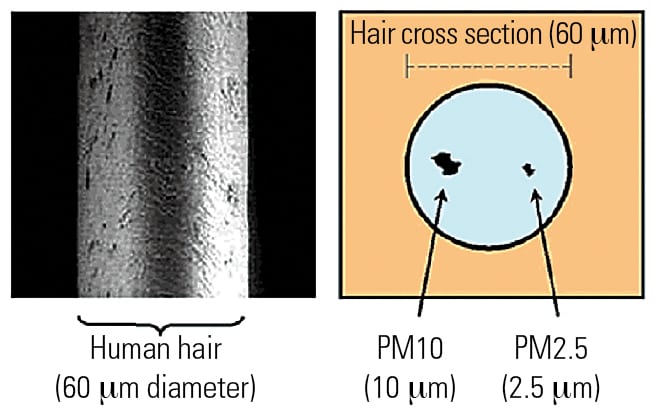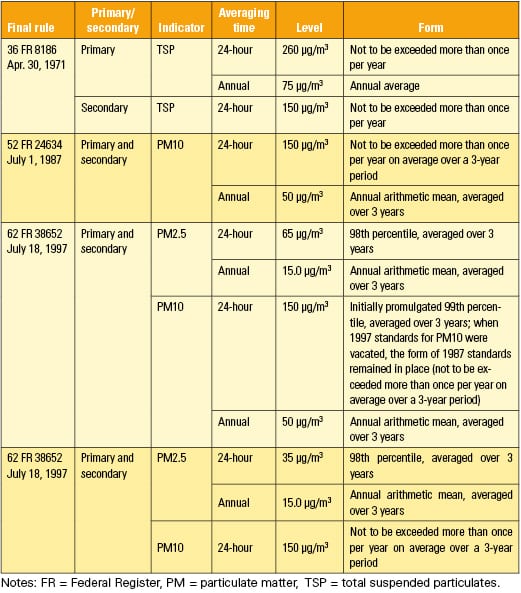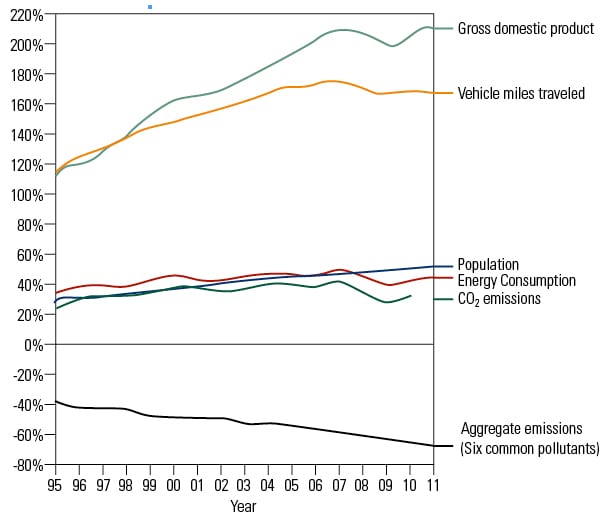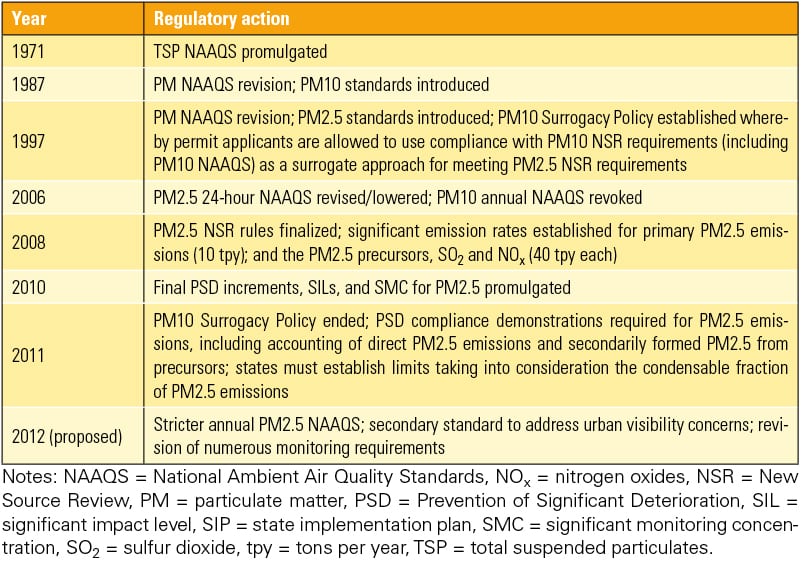Hazy Timetable for EPA’s Proposed Tighter PM2.5 Standards
On June 15, in response to a court order, the U.S. Environmental Protection Agency (EPA) proposed new lower limits on particulate matter (PM) emissions that are scheduled for release in mid-December, although that deadline may be missed. Even with implementation delays, now is a good time to start paying closer attention to the requirements of the proposed standard.
Particulate matter (PM) is a complex mixture of extremely small particles and liquid droplets. PM comprises a number of components, including acids (such as nitrates and sulfates), organic chemicals, metals, and soil or dust particles. The size of particles is directly linked to their potential for causing health problems. The U.S. Environmental Protection Agency (EPA) is concerned about particles that are 10 micrometers in diameter or smaller (PM10) because those are the ones that generally pass through the throat and nose and enter the lungs. Once inhaled, these particles can affect the heart and lungs and cause serious health effects (Figure 1).

1. Particulate policy. Particulates of different diameters have different effects on the human body and often originate from different sources. PM10 and PM2.5 particles are easily inhaled and penetrate airways and lungs. Source: California Environmental Protection Agency Air Resources Board
Particles may be emitted directly or formed in the atmosphere by transformations of gaseous emissions such as sulfur oxides (SOx), nitrogen oxides (NOx), and volatile organic compounds (VOCs). Examples of secondary particle formation include the following:
- The conversion of sulfur dioxide (SO2) to sulfuric acid droplets that further react with gaseous ammonia to form various sulfate particles such as ammonium sulfate.
- Reactions involving gaseous VOC yielding organic compounds with low ambient temperature (saturation) vapor pressures that condense on existing particles to form secondary organic aerosol particles.
The EPA groups particle pollution into two categories:
- Inhalable coarse particles, such as those found in industries handling dusty materials like coal, are larger than 2.5 micrometers and smaller than 10 micrometers in diameter. These particles are classified as PM10.
- Fine particles (PM2.5), such as those found in smoke and haze, are 2.5 micrometers in diameter and smaller. These particles can be directly emitted from sources such as forest fires, or they can form when gases emitted from power plants react in the air.
Due to environmental concerns, coal-fired power plants are required to operate a particulate collection system to control the release of particulate emissions. These systems include inertial collectors (cyclone collectors), fabric filter collectors (baghouses), wet scrubbers, and electrostatic precipitators.
POWER has published a variety of articles about PM standards and PM control technologies. The most recent examples (available in the archives at https://www.powermag.com) include “Particulate Matter Air Quality Standards Continue to Evolve” (June 2011) and “EPRI Bridges Industry R&D Gaps” (January 2012).
Regulating Particulates in the Past
The first rules regulating PM were promulgated in 1971 under the Clean Air Act (CAA). Since that time, the EPA has continually updated the PM standards (Table 1) to better protect human health and the environment. The CAA’s centerpiece has been the national ambient air quality standards (NAAQs), which were established for six pollutants: sulfur dioxide, NOx, PM, carbon monoxide, ozone, and lead (Figure 2).

Table 1. Early evolution of PM standards. The first rules regulating particulate matter were enacted in 1971 under the Clean Air Act. Since that time, the EPA has continually updated PM rules under the National Ambient Air Quality Standards (NAAQS). By law, the agency cannot consider costs in setting or revising NAAQS. Source: EPA

2. The air is getting cleaner. This graph illustrates the reduction in the amount of the six common pollutants (SO2, NOx, PM, CO, ozone, and lead) in relation to other key economic indicators over the past two decades. Source: EPA
PM’s chemical and physical properties vary greatly with time, region, meteorology, and source category, thus complicating the assessment of health and welfare effects. Since the EPA completed the last PM standards review in 2006, the agency has examined hundreds of new studies. The new evidence includes more than 300 new epidemiological studies, many of which report adverse health effects even in areas that meet the current PM2.5 standards. The EPA also has considered analyses by agency experts.
Court Order Drives EPA’s New Proposed PM Standards
Under the CAA, the EPA is required to consider revising its PM standards every five years, and it last did so in 2006. Yet, as the agency approached the five-year deadline in October 2011, it announced that it wanted to delay issuing revised PM rules until the summer of 2013 because it needed more time to sift through the latest scientific research.
Eleven states, including New York and California, plus the American Lung Association and the National Parks Conservation Association, challenged the delay in court, arguing that it violated the CAA. On June 2, 2012, Judge Robert L. Wilkins ruled in the case ( American Lung Association v. U.S. Environmental Protection Agency, U.S. District Court, District of Columbia) and ordered the EPA to sign a proposed rule by June 7, a deadline that was later extended under an agreement between the agency and the plaintiffs.
On June 14, the EPA proposed to strengthen the NAAQS for PM2.5. The agency also proposed to retain the existing standards for PM10. The agency said that its proposed changes to the PM2.5 standards are consistent with advice from its independent science advisors, the Clean Air Scientific Advisory Committee (CASAC).
Specifically, the agency proposed to take the following actions:
- Strengthen the annual PM2.5 health standard by setting the standard at a level within the range of 12 micrograms per cubic meter (μg/m3) to 13 μg/m3. The current annual standard, 15 μg/m3, has been in place since 1997.
- Retain the existing 24â€hour fine particle standard, at 35 μg/m3. The EPA set the 24â€hour standard in 2006.
- Set a separate PM2.5 standard to improve visibility, primarily in urban areas. The EPA is proposing two options for this 24â€hour standard: at 30 deciviews or 28 deciviews. (A deciview is a yardstick for measuring visibility.)
- Retain existing secondary standards for PM2.5 and PM10 identical to primary standards to provide protection against other effects, such as ecological impacts, effects on materials, and climate impacts.
The EPA also proposed to retain the existing 24â€hour standard for PM10. This standard, with a level of 150 μg/m3, has been in place since 1987.
The EPA also made the following proposals:
- Grandfathering preconstruction permitting applications that have made substantial progress through the review process at the time the final standards are issued. The agency is taking this action to ensure a smooth transition to the new standards.
- Making updates and improvements to the nation’s PM2.5 monitoring network that include relocating a small number of monitors to measure fine particles near heavily traveled roads. The EPA’s proposal does not require additional monitors.
- Updating the Air Quality Index for particle pollution.
The EPA anticipates making attainment/nonattainment designations by December 2014, with those designations likely becoming effective in early 2015. A nonattainment area is a location considered to have air quality worse than the NAAQS as defined in the CAA Amendments of 1970. Nonattainment areas must have and implement a plan to meet the standard. An area may be a nonattainment area for one pollutant and an attainment area for others.
States would have until 2020 (five years after designations are effective) to meet the proposed health standards. Most states are familiar with this process and can build on current work to meet the news standards. A state may request a possible extension to 2025, depending on the severity of an area’s PM2.5 problems and the availability of pollution controls.
The CAA does not specify a date for states to meet secondary PM2.5 standards; the EPA and states determine that date through the state implementation planning process. The same controls that will be installed to meet the primary, healthâ€based standards will also help areas meet the secondary standards. In 2020, the EPA expects virtually all counties will meet the secondary standards without state/local reductions. By law, the agency cannot consider costs in setting or revising NAAQS.
The EPA intends to issue a regulatory impact analysis that will estimate the potential benefits and costs of meeting a revised annual health standard in the year 2020. The proposed standards are expected to yield significant health benefits, valued at $2.3 billion to $5.9 billion annually for a proposed standard of 12 μg/m3 and $88 million to $220 million annually for a proposed standard of 13 μg/m3, according to the EPA. The EPA will issue final standards by Dec. 14, 2012, after holding hearings to seek public comment. The proposed standards reflect the continuing trend of tightening the PM NAAQS over time (Table 2).

Table 2. Regulatory milestones for PM NAAQS and related compliance assessment requirements. Source: EPA
How New PM Rules Affect the Power Industry
In August, POWER interviewed Block Andrews, PE, director of Strategic Environmental Solutions, and Robynn Andracsek, PE, associate environmental engineer, Environmental Studies and Permitting Division, with the engineering firm Burns & McDonnell about the new PM standards.
“Previous government studies have shown that the biggest environmental ‘bang for your buck’ is from reduction of fine particulate matter,” Andrews said. “But, have we gotten to the point of diminishing returns? I don’t know; I will defer this answer to the toxicologists and economists.”
Andrews said that the EPA has a process for evaluating the ambient air quality standards that includes a working group (CASAC) with toxicologists that evaluates health-based studies and uses the results to set the NAAQS.
PM2.5 can be in a filterable (solid) form, or a sulfate or nitrate condensable form, Andrews said. For the filterable portion, air dispersion modeling can be a problem if the PM2.5 standard is lowered, especially with coal-fired plants’ fugitive emission sources such as ash handling and road and coal pile dust. He said, “Background PM2.5 levels today are around 80% of the proposed standard. This does not allow many additional impacts from an existing or new facility.”
Andrews explained that sulfate formation is a chemical transformation of SO2 emissions. Natural gas combustion is relatively free of SO2 emission, but a coal plant stack’s SO2 emissions will form sulfates. Nitrate formation is a chemical transformation of NOx emissions. Both coal and natural gas combustion would be expected to form nitrates.
Primary standards provide public health protection, including protecting the health of “sensitive populations such as asthmatics, children, and the elderly,” Andrews said. Secondary standards provide public welfare protection, including protection against decreased visibility and damage to animals, crops, vegetation, and buildings.
In addition, the EPA is proposing a new visibility standard for the secondary NAAQS. Some of the same atmospheric chemistry that converts SO2 and NOx to form sulfates and nitrates can also impact visibility, Andrews said.
“A good amount of work to determine regional haze impacts on Class I areas has been performed. I have not seen any determinations of visibility outside of the Class I, so it is unclear (no pun intended) what, if any impacts this may have on the coal and natural gas power plants beyond the primary standard,” Andrews said. “My concern is that the visibility modeling results have not always correlated well with the ‘real world’ results. This could require industry/industries to spend money without a real visibility reduction return.”
Andracsek explained that the model required for demonstrating compliance with the PM2.5 NAAQS is AERMOD, which is the EPA’s most commonly used air dispersion modeling program. “It has been around for several years. The problem comes in getting the model to demonstrate PM2.5 NAAQS compliance. The sum of modeled impacts from the source, plus impacts from their neighbors within at least 50 kilometers, plus the background concentration is what must be compared to the now lower PM2.5 annual NAAQS,” she said.
There are two main issues related to proving PM2.5 NAAQS compliance, according to Andracsek.
First, PM2.5 is made up of primary PM2.5 and secondary PM2.5. Primary PM2.5 is what is normally thought of as very fine dust. Secondary PM2.5 is formed from NOx, SOx, VOCs, and ammonia that react chemically in the air to form fine particulates. The EPA does not yet have a method to calculate or model secondary PM2.5, other than using SOxand NOx as surrogates. “This leaves a hole in complying with any PM2.5 NAAQS,” she said.
Second, the background levels for PM2.5 in many parts of the country are 8 mg/m3 to 11 mg/m3. “When the NAAQS is lowered from 15 mg/m3 to 12 mg/m3 or 13 mg/m3, the background does not change,” Andracsek said. “This leaves an even smaller amount of available room for source emissions. Combined with the fact that the models are quite conservative, modeling compliance with the PM2.5 NAAQS at 15 mg/m3 is problematic; modeling compliance at 12 mg/m3 to 13 mg/m3 is stifling.”
The cost to run PM2.5 modeling at a facility varies greatly, depending on the specific circumstances, according to Andracsek. Modeling stacks is much easier and faster than modeling fugitive emissions. A lot of primary PM2.5 is from fugitive emissions. “A dispersion modeling project would run from $15,000 to $50,000 and take from one to six months,” she said. “This is a very rough estimate. Compliance costs will vary depending on what controls may be required to comply with the PM2.5 NAAQS.”
The rule states that, for now, meeting the 24-hour PM2.5 NAAQS is sufficient to demonstrate that the secondary visibility standard is attained, Andracsek said. So if the EPA issues its guidance along with the revised final rule, there should be no further analysis above the “normal” PM2.5 analysis and, therefore, no additional cost above that needed to run the model described above. There is a lot of uncertainty, however, as to whether or not the surrogacy policy would be allowed to stand in court, especially in light of the fact that visibility is already considered for Class I analysis and the Best Available Retrofit Technology regulations.
Andracsek explained that if the EPA releases the new standard before the guidance is finalized, applicants might then have to follow the Federal Land Managers’ Air Quality Related Values Work Group’s 2010 analysis for long-range visibility (such as regional haze) impacts, which would add $50,000 and three months, or more, to the project’s cost. She added, “It may not be possible to even meet the regulation given the uncertainty about the methodology. A big part of the PM2.5 problem is the uncertainty and lack of understanding about how these very fine particulates behave in the atmosphere.”
The Impact of CSAPR’s Nullification
On August 21, 2012, the U.S. Court of Appeals for the D.C. Circuit vacated the Cross-State Air Pollution Rule (CSAPR). Andrews discussed the impact of the CSAPR’s nullification on coal-fired and gas-fired power plants that have to install new air pollution control equipment in order to comply with the proposed PM2.5 NAAQS.
“There have been two rules that were driving PM2.5 controls: CSAPR and the PM2.5 NAAQS. Since CSAPR has been vacated, it is unlikely that EPA will have a replacement rule in the near future. In fact, it took EPA three years to replace the original CAIR [Clean Air Interstate Rule],” he said.
After a new CSAPR or similar rule is finalized, the states will be given an opportunity to develop a State Implementation Plan (SIP), which will have to be approved by the EPA and give a reasonable timeframe for compliance, according to Andrews. “It could easily be five years or more before any CSAPR compliance would be expected,” he said.
The NAAQS regulatory process can be the timeframe driver as well, Andrews explained. A typical process would require states to monitor PM2.5 (which has been happening for several years), submit to the EPA a list of non-attainment areas, develop SIPs for compliance, obtain EPA approval of the SIPs, and then require controls in or near non-attainment areas.
“The EPA may set a timeframe for this process, but history tells us that the timeframe is not always reliable for a variety of reasons. It could easily be five years or more before any PM2.5 NAAQS compliance would be expected,” Andrews said. “The bottom line is that a controls timeframe is uncertain. History tells us that NAAQS-driven control requirements are rarely required immediately.”
Will Plants Require New Equipment to Meet Stricter PM Standards?
Andrews explained that for fugitive dust emissions, meeting the new standard could require more enclosed coal piles and further fugitive dust reduction techniques, such as road paving, surfactants, and baghouses, where feasible. “For SO2 and NOx emissions, further reductions could be required such as scrubbers and selective catalytic reduction (SCR) technology,” he said.
POWER asked Andrews if he thinks the air pollution control equipment currently used by most U.S. coal-fired and gas-fired power plants will be sufficient to enable them to comply with the proposed secondary PM2.5 NAAQS. He answered, “I don’t think we know at this point what scale of reductions will be required to meet the proposed visibility standards. However, if the 24-hour PM2.5 surrogate policy continues to be in place, then it would have a limited impact.”
Andrews had no estimates about the costs of installing air pollution control technology that would enable fossil-fired plants to comply with the proposed PM standards. He explained that he would first have to know if the power plants in question are going to retrofit a unit, retire, build new generation, or rely on the market for power. “Once we know this answer, then we would have to know the stringency and form of the regulation(s),” he said.
When discussing the probable impact that air pollution control upgrades will have on affected power plants’ bottom lines, Andrews referred to the “good old days when there were fewer moving parts in the environmental arena.” He explained that today there is great uncertainty about the required controls and cost impacts related not only to air regulations, but also water and coal combustion residuals regulations.
Is retrofitting a coal unit cost competitive compared to buying market power or other forms of energy such as natural gas combustion? An answer to this question is quite utility-specific, according to Andrews. It will depend on many factors, including delivered fuel costs, environmental costs, the power market pricing in specific geographical areas and the individual utility’s future projections of key cost and risk issues
“Historically, energy companies have done a great job of balancing regulations, ratepayer costs, and—for investor-owned utilities—a reasonable rate of return for the shareholders,” Andrews said. “Their job is even harder today, but I am confident that they will continue to perform well.”
EEI Responds to Proposed PM Standards
The Edison Electric Institute (EEI), an association of shareholder-owned electric companies, filed its comments about the proposed PM standards with the EPA on August 31, and referred to the “regulatory treadmill of NAAQS standards.” The group said that if the proposed PM rules are finalized, the EPA will be adding to the already existing list of separately enforceable PM NAAQS. Accoring to the EEI, finalization of the proposed PM rules would mean that the EPA and the states will be concurrently implementing:
- The 1997 PM2.5 annual standard.
- The 2006 PM2.5 24-hour standard.
- A new 2012 PM2.5 annual standard.
- A potentially revised 2012 PM2.5 24-hour standard.
- The 1987 PM10 24-hour standard.
- A new 2012 secondary PM2.5 visibility standard.
- The 2006 secondary PM2.5 standards as newly targeted on “other” welfare effects apart from visibility.
Under the EPA’s currently planned schedule for NAAQS reviews, a new ozone standard could be promulgated in 2014 that would layer on top of existing standards and potentially add another secondary standard to the two 2012 PM2.5 secondary standards, according to the EEI. In addition, during this time period, the newly revised NO2 and SO2 NAAQS will be implemented, requiring additional designations and SIP submittals.
The EEI said that the EPA needs to do “a far better job of coordinating these regulations and minimizing their overall burden for the agency itself, states, and regulated entities.” The current situation causes “an immense waste of resources” and, given the lengthy process of designating new nonattainment areas and revising SIPs, fosters years of uncertainty for states, local governments, and industry that are affected by revised NAAQS, it said. The industry group commented that the EPA should, instead, seek to rationalize its NAAQS process to better conform to existing executive orders.
Looking Ahead
Currently, the proposed PM standards’ implementation timeline is unpredictable because of the complicated implementation process. The most likely scenario would require the individual states to monitor PM2.5, submit a list of non-attainment areas to the EPA, develop SIPs for compliance, obtain EPA approval of the proposed SIPs, and then require controls in or near non-attainment areas.
Even though the implementation process could take as long as five years, regulated facilities need to start planning for how to deal successfully with compliance and permitting issues. The increased complexity of PM2.5 NAAQS compliance will no doubt boost facility costs and staff work hours. Therefore, it is important to begin assessing projected PM2.5 emissions and possible permitting problems to prepare for and, hopefully, avoid permitting hurdles and delays.
— Angela Neville, JD is senior editor of POWER.